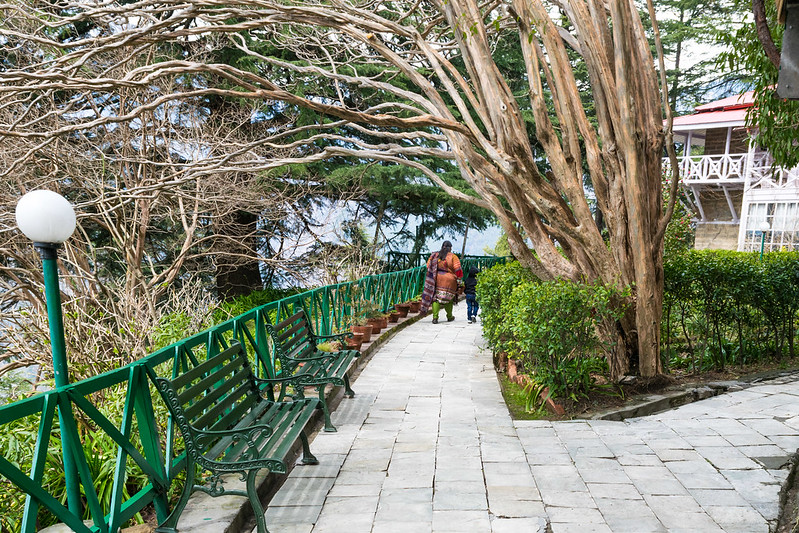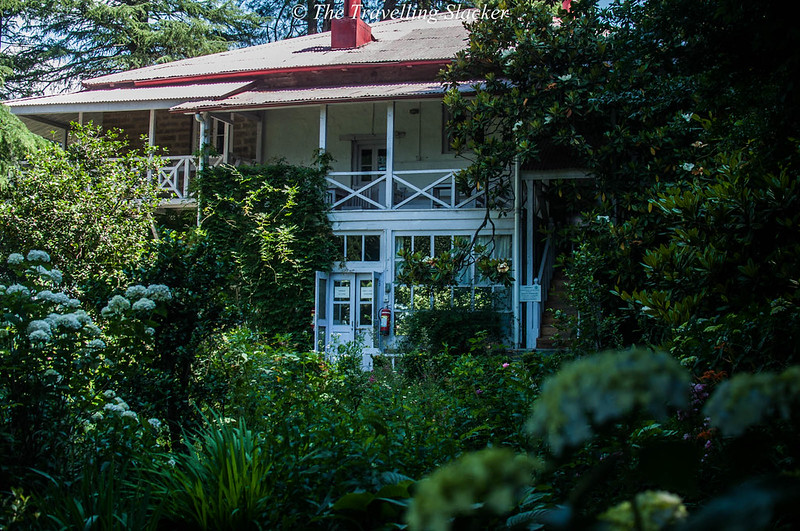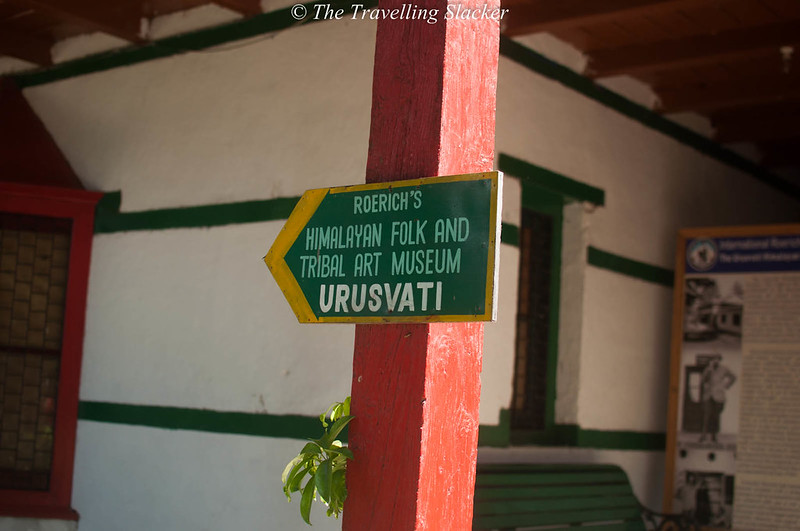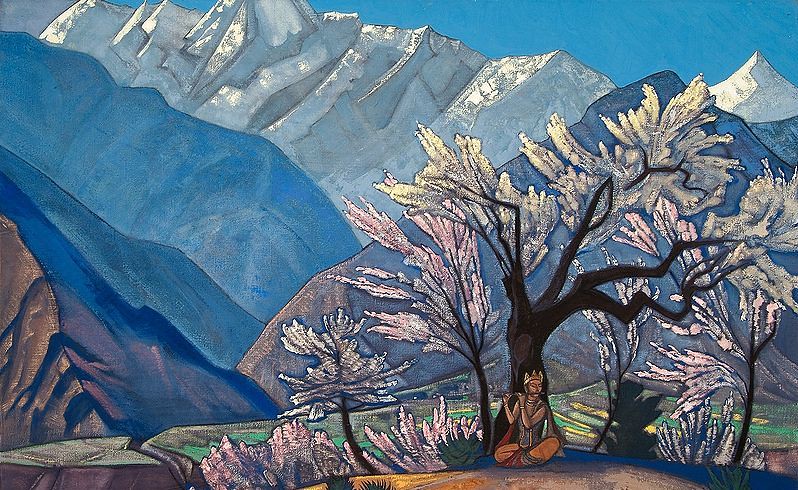In the shady groves of Naggar is a house with white window sills and balcony railings. Green fern and ivy have grown over part of it, but instead of resembling worn-down, simply adds to its character. It looks warm and inviting and is exactly the kind of house you think an artist would live in. This is the Roerich Estate, once home to Nicholas Roerich, a renowned Russian painter. Visiting this has to be on your list of things to do in Naggar, but if you’re the artistic type and want to know more about it, look no further. Read all about it in our exploration of the Roerich Estate, Naggar.

Going Back In Time
Born in St. Petersburg, Russia in 1876, Nicholas Roerich was drawn to the humanities from a young age. He showed a keen interest in art, philosophy, history, and poetry, and his marriage to Helena Shaposhnikov further fueled his desire to know more about philosophy. Delving into the world of philosophies like Vedanta, Roerich began to study texts like the Bhagavad Gita and the works of Tagore, who was both his contemporary and friend. All the while, World War I ravaged entire nations, and people the world over were recovering from the violence around them.
In 1923, he embarked on a journey to Central Asia with his family, in search of a place with peace and serenity. He chronicled his journey in great detail in a book titled ‘Shambala’, after the name of the place somewhere in the Himalayas that promised this serenity he was in search of. This was just the beginning of a long and affectionate relationship with the hills and mountains, many of which he immortalized in his paintings.
The cottage that he eventually called home was built by an English Colonel in 1880, which explains its architecture and style. The Roerichs first laid eyes on the cottage on a frosty morning. Surrounded by trees, backdropped by the breathtaking landscape of Naggar’s hills, with a view of the valley and the Beas flowing through, Roerich fell in love with the house. He bought it from the owner, the Raja of Mandi, and it was here that he spent the last 20 years of his life.
Exploring The Estate
Roerich Estate in Naggar has the bungalow that the Roerichs called home and the Urusvati Institute. A stony path leads you to the front door of the house, passing between overgrown shrubs and camellias that Helena Roerich herself had planted all those years ago. Depending on what time of the year you visit, you’ll see different flowers in bloom, from lilies and chrysanthemums to daffodils, roses, and irises.

The Roerich Art Gallery
Heading to the southern entrance of the house, covered in rambling rose, you enter the Roerich Art Gallery. The lower floors of the cottage have been converted into the Gallery by Nicholas Roerich’s son, Svetoslav Roerich, in the early 1960s. The floors originally had the studio of Nicholas and his eldest son. Today, these exhibit Nicholas’ Himalayan series, while pictorial works by Svetoslav Roerich are in a third hall, formerly his study.
The rooms in which the family resided are closed to visitors, but glass windows enable you to get a peek at their life. The rooms have been reconstructed from references of old photographs to resemble what they looked like in their heyday. You can peek into the dining room and glimpse at the antiques from their family collection and at the cutlery on the table.
The Roerichs’ Memorial House
The first floor was the sanctuary of the family, where their most important works were created. Visitors were rarely taken upstairs by the family, and even today, a gallery enables guests to walk around and peep into the rooms from windows. You can look into Helena Roerich’s study, the family’s living room and library where they gathered each evening, and their son Svetoslav’s studio. In 1945, he married famous Indian actress and grandniece of Rabindranath Tagore Devika Rani, and his studio went on to become her study.

Urusvati Himalayan Research Institute
“The ‘Urusvati’ place of research, place of science, must be built in the Himalayas, within the borders of ancient Aryavarta. Again the human spirit, purified by the continuous currents of the Himalayas, will search in tireless labor.”
Nicholas Roerich
After you’ve explored the cottage, head up the path rising up across the road. You’ll come to the Urusvati Institute, hidden among deodars, and established by the Roerichs after their Central-Asian expedition in 1928. Urusvati means ‘The Light of the Morning Star’ in Sanskrit. The institute houses the Himalayan Folk Art Museum, a research library, guest rooms for scholars who visited, a science museum, and some other exhibitions.

The Institute was the brainchild of the Roerichs and was an intellectual culmination of all the things the family was interested in. Several exhibitions to study the rich flora and fauna of the Himalayas were held here, as well as expeditions. The Museum contained geological, ornithological, botanical, and archeological collections, all of which were being constantly expanded by the family and by the researchers that visited.
Activity at the Institute had to be suspended by the late 1930s due to brimming hostilities the world over, which eventually led to World War II. But today, years later, experts from the International Roerich Memorial Trust and the International Centre of the Roerichs are working together to look into the Institute’s revival based on the family’s evolutionary ideas.
Visiting The Roerich Estate
The Roerich Estate is open on all days except Mondays and a few national holidays (Republic Day, Independence Day, Gandhi Jayanti, Christmas, Holi, Diwali). It is open from 10 am to 5 pm, and one adult ticket costs INR 50. Photography in the house is prohibited, but you can always click photos of the breathtaking views.
You can reach the Estate after a pleasant walk from the Naggar Castle, about 1.5 km away and easily one of the must-see sights in offbeat Naggar. The walk itself shows you how easily one can fall in love with a region as rich as this.
Leaving Behind A Legacy
Apart from Nicholas Roerich’s art and books, the entire family has left behind several works worth preserving. The Roerich family legacy is revered and protected not just in India, but also back in Russia. Nicholas’ son Svetoslav and his wife Devika Rani founded The International Roerich Memorial Trust (IRMT) in 1992-93, with the support of the Embassy of the Russian Federation in the Republic of India, the Government of India and the Government of Himachal Pradesh.
They did this so that the efforts of Nicholas and their entire family may be preserved and promoted, as they rightly deserved. The Roerich Estate is still being analyzed to further make it a scientific and cultural center.

Conclusion
In the 1970s the Archaeological Survey of India took an initiative to mark significant contributors to the field of art in India, and as such released a list of India’s Navratnas. These nine artists are regarded as art treasures of India, and among them is Nicholas Roerich. He had a passion for the hills and for his many interests like no other and was determined to keep learning about it all for as long as he could. The Roerich Estate in Naggar is part of the testimony of his work and is a must-visit for anyone who finds themselves admiring the hills as Roerich himself once did.
If you find yourself in Naggar, make sure you look up goSTOPS. We may not be an artistic cottage, but we’re colorful, fun, and affordable. Plus, we can promise some stunning views as well!
FAQs
Where Is The Roerich Art Gallery Located In Himachal?
The Roerich Art Gallery is on Roerich Estate, in the town of Naggar. It is 1.5 km away from the Naggar Castle.
Did Nicholas Roerich Know Nehru?
It wasn’t Nicholas Roerich but his son Svetoslav Roerich who knew Jawaharlal Nehru. Nehru had awarded him the International Award and the Padma Bhushan. In fact, his paintings of Nehru and Indira Gandhi hang in the Central Parliament Hall in New Delhi.
Where Is The Nicholas Roerich Museum?
The Nicholas Roerich Museum is in New York City, dedicated to his works and making them accessible to people across the world.


